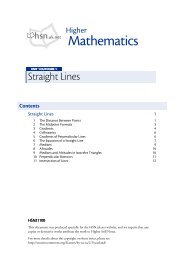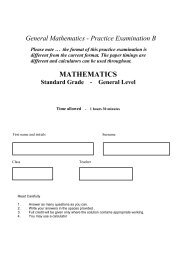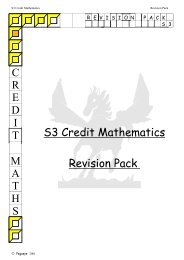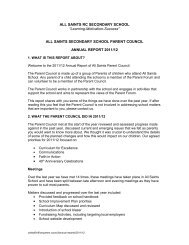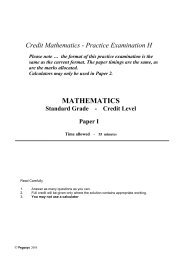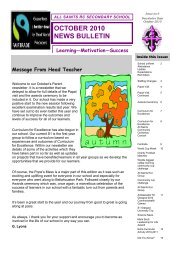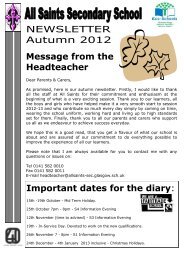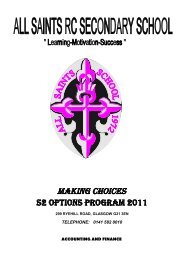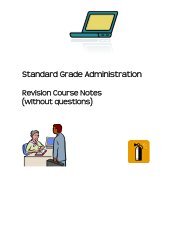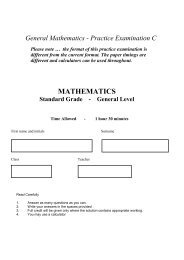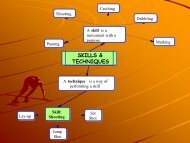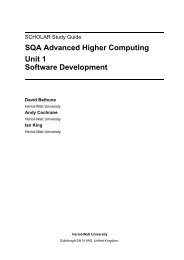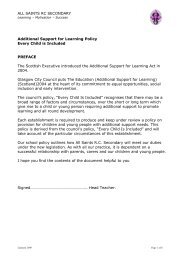Higher Still Booklet - All Saints Secondary School
Higher Still Booklet - All Saints Secondary School
Higher Still Booklet - All Saints Secondary School
Create successful ePaper yourself
Turn your PDF publications into a flip-book with our unique Google optimized e-Paper software.
<strong>Higher</strong> <strong>Still</strong> English Explained
Helping Your Child with <strong>Higher</strong> English<br />
Introduction<br />
We’ve designed this booklet to give you information about the <strong>Higher</strong> English Course and<br />
so that you can help your child with the key skills that they will have to master in order to<br />
be successful in the final <strong>Higher</strong> <strong>Still</strong> exam.<br />
In addition, to <strong>Higher</strong> <strong>Still</strong>, the English Department also offers ESOL (English for Speakers<br />
of Other Languages at <strong>Higher</strong> <strong>Still</strong> Levels)<br />
Course Structure<br />
Internal Assessment<br />
There are two units of study and each is assessed by NABs. These are exams from the<br />
SQA’s National Assessment Bank and these are done in class under controlled conditions.<br />
1) Language Study – Close Reading and Writing NABs<br />
2) Literary Study – Textual Analysis NABs<br />
These units must be passed in order to be presented for the final exam.<br />
External Assessment<br />
The external examination lasts for 3 hours and 15 minutes. There are two papers:<br />
1) Close Reading (1 Hour 45 minutes) 40% weighting<br />
2) Critical Essay (1 Hour 30 minutes) 40% weighting<br />
Close Reading<br />
In response to a series of questions, candidates are required to demonstrate their ability<br />
to understand, analyse and evaluate two thematically linked passages of unseen prose.<br />
Some questions will require candidates to compare ideas and/or style between the two<br />
passages.<br />
We have included some more detailed information on types of close reading questions<br />
and useful formulas on how to answer questions later in this booklet.<br />
Critical Essay<br />
Selecting from a range of questions candidates are required to write two Critical Essays,<br />
each on a different genre, chosen from the following: drama, prose and poetry. In the<br />
course of their responses candidates are be required to demonstrate their ability to<br />
understand, analyse and evaluate previously studied texts. However, candidates are not<br />
allowed to take notes/books into the exam. Quotes must be memorised and notes on<br />
plot, characters, themes, setting, style, structure and language must be learned.<br />
We have included some more detailed information on how you can help your child to<br />
revise for the Critical Essay Paper later in this booklet.
Folio of Writing 20% weighting<br />
Two pieces of writing must be submitted and will be sent to the SQA for grading<br />
purposes:<br />
one piece of writing must be creative<br />
one piece of writing must be discursive<br />
It is essential that your son/daughter keeps up to date with homework and deadlines and<br />
in order to ensure you are aware of English deadlines we have included our departmental<br />
deadlines sheet on the next page<br />
Close Reading<br />
You can help your child with their close reading skills by doing the following:<br />
Ensure there are quality newspapers around the house and encourage your child<br />
to read them.<br />
Discuss their style, content, vocabulary, arguments and structure – all of these aspects<br />
will belooked at in the Close Reading Paper.<br />
<br />
<br />
<br />
<br />
<br />
Watch a documentary like ‘Panorama’ or a discussion programme like ‘Question<br />
Time’. Askyour child questions to test their understanding.<br />
Test your child’s knowledge of critical terminology. Are they familiar with simile,<br />
metaphor, imagery, personification, onomatopoeia, hyperbole, alliteration,<br />
assonance? We have included definitions and examples in this booklet to help<br />
with this. Ask your child to find examples of the above techniques in newspaper<br />
articles and discuss their effectiveness with them.<br />
Play vocabulary games with your child. Each find 5 testing and interesting words<br />
(e.g. pugnacious, fraternal, dogmatic) but not impossible (zeugma, triptych,<br />
proselytize). Give two points if they get the meaning correct and one if they work<br />
it out when you put it into a sentence. This will test their ability to work out the<br />
meaning from the context.<br />
Buy past papers and encourage your child to complete the Close Reading papers.<br />
Go over the answers with them and help them to see how they can improve their<br />
mark.<br />
Go over the Close Reading Information Sheets included in this booklet. Help your<br />
child to identify the different types of questions and help them to frame an<br />
answer using the formulas for each type of question.<br />
Critical Essay Writing<br />
You can help your child with critical essay writing by doing the following:<br />
<br />
Help them to understand the text. Perhaps you could also read the<br />
play/novel/poetry that your child is studying. Encourage your child to read the<br />
text again and discuss aspects such as plot, characters, themes, setting, style,<br />
structure and language.
Test your child’s knowledge of key quotations for each text studied. Do they<br />
know them accurately and do they know why they are important?<br />
Encourage your child to use past paper questions. Ask them to highlight key<br />
words in the question. They must focus on the task and answer the question.<br />
Then ask them to write the opening paragraph and plan for a number of essays.<br />
Check your child has notes on character, themes, setting etc for each text they<br />
have studied.<br />
Ask them to produce their own study notes for each text and help them to learn the<br />
information. Encourage them to use mind – maps, spider grams and prompt cards.<br />
Writing Folio<br />
You can help your child with their writing folio by doing the following:<br />
Read over their drafts and check for accuracy in terms of punctuation and paragraphing<br />
Help them with research and ideas for discursive essays by discussing topical subjects<br />
that are on T.V and in the quality press.<br />
Encourage your child to use literary techniques such as similes and metaphors in their<br />
writing.<br />
In Personal/Reflective essays check that they have written about their thoughts and<br />
feelings in detail. Your child should choose a memory or incident which allows some<br />
honest and interesting reflection. They should aim to convince the reader that the<br />
incident genuinely means something to them and that they have learned something from<br />
the experience.<br />
Check that descriptions are detailed and focuses on all the senses and not just what they<br />
saw.<br />
In short stories there must be a plot, character development, setting and climax. The<br />
story<br />
should be realistic, well structured and there should be an underlying theme evident or<br />
perhaps strong sense of place.<br />
<br />
<br />
At <strong>Higher</strong> level the minimum length for each piece is 650 words and the maximum<br />
is 1300 words. (2 essays)<br />
At Intermediate 2 the length should be between 500 and 1000 words (2 essays)<br />
At Intermediate 1 the length should be between 300 and 600 words (1 essay)<br />
Your child should not exceed this limit<br />
Useful Resources<br />
Past Papers – published around now<br />
How to Pass <strong>Higher</strong> English
Colin Eckford and Ann Bridges (published by Hodder)<br />
How to Pass Close Reading<br />
Colin Eckford and Ann Bridges (published by Hodder)<br />
The Sunday Herald Essay<br />
Every Sunday in the Sunday Herald and most broadsheet newspapers<br />
www.sqa.org.uk<br />
There is a section for learners<br />
www.bbc.co.uk/scotland/learning/bitesize/higher<br />
Lots of advice and practical help<br />
Check the school website for other useful resources.<br />
<strong>Higher</strong> /INT 2/INT 1 English – Course Deadlines<br />
2010/2011 NABs:<br />
Writing Folio and NAB<br />
Writing Personal/ Reflective – First Draft – End of September<br />
Writing 1 Personal/ Reflective – Second Draft – End of October<br />
Writing 2 Discursive/ Persuasive – First Draft – Mid November<br />
Writing 2 Discursive/ Persuasive – Second Draft – Start of December<br />
Writing 3 (both) – mid January<br />
Final Submission of Writing Folio – Friday 25 February<br />
First NAB Assessment Block – W/B Monday 25 October 2010<br />
Textual Analysis NAB<br />
Second NAB Assessment Block – W/B Monday 24 th January 2011<br />
Close Reading NAB<br />
Pupils will sit NABs for the level they are currently entered for<br />
Resit NAB Assessment Block – W/B Monday 28 February 2011<br />
Close Reading NAB<br />
Textual Analysis NAB<br />
Pupils will sit NABs for the level they are currently entered for<br />
Other Deadlines:
S5/S6 Prelims: 31 st Jan – 18 February 2010<br />
ENGLISH FOR SPEAKERS OF OTHER LANGUAGES<br />
ESOL is a comparative qualification for our young people for whom English is a second<br />
language in order to raise attainment and meet pupils’ needs.<br />
ESOL assesses the four skills of Speaking, Writing, Listening and Reading. The topics and<br />
tasks covered are relevant to the learners and are related to everyday work, study,<br />
community and social situations.<br />
The ESOL Intermediate 1 course is internally moderated and there is no external exam.<br />
Due to its success we now provide the ESOL course at <strong>Higher</strong> level. These courses follow<br />
the same model but include an External Exam as follows:<br />
External Assessment<br />
<strong>Higher</strong> Exam:<br />
Paper 1 - Listening - 3 x texts (30 x minutes)<br />
Paper 2 - Reading - 2 x texts (40 x minutes)
Understanding (U)<br />
Factual<br />
<br />
<br />
Look in the text for information which will answer the question.<br />
Define the word. Say how it relates to the question.<br />
Answer in your own words unless you are asked to directly quote.<br />
“Summarize..”<br />
Look at the number of marks.<br />
Each mark = each piece of evidence you need to make.<br />
“How does the passage help you to understand the meaning of a word”?<br />
Formula – Summarizing Questions<br />
1. Define the word.<br />
2. Show how the rest of the sentence makes this clear.<br />
3. You do this by quoting the words in the sentence and their relationship to the word in<br />
question.<br />
A link question<br />
These questions ask you to identify a word or phrase which links back to the previous<br />
point or argument and at the same time, points forwards to another paragraph.
Formula – Link Questions<br />
1. Here you need to identify in the linking sentence 2 words or phrases.<br />
2. One that points back and one that points forward.<br />
3. You then have to link the backward pointing one to the previous paragraph and then<br />
the forward to the next paragraph.<br />
How does the writer express their ideas?<br />
Analysis (A)<br />
Not understanding of the passage.<br />
It’s not what is being said, it’s how it is being said.<br />
Analysis deals with style.<br />
How some words may be more powerful than another – why the author used the word<br />
they did!<br />
Once you have identified the techniques in the phrase –<br />
You have to say how well it does its job.<br />
Remember- the writer CHOSE this WORD for a reason. The reason is to create an effect in<br />
you-the reader’s-mind.<br />
Every time you answer an analysis question you have to remember to consider.<br />
Word Choice<br />
Why did the writer choose a certain word?
Because of the connotation of the word. This is the words which contribute to the impact<br />
of a word.<br />
<strong>All</strong> the marks you get will come from identifying the word/s.<br />
Then discussing the connotations of the word/s<br />
.<br />
Formula – Word Choice Questions<br />
1. Identify the word.<br />
2. Quote it.<br />
3. Discuss the connotations of the word.<br />
Imagery<br />
This is the most frequently asked and most powerful aspect of close reading.<br />
You need to be able to identify imagery and you also need to be able to comment on why<br />
it works so well. Simile and metaphor are devices of comparison, and work by making<br />
pictures in your mind.<br />
You need to be able to show that you can identify the main techniques for imagery.<br />
Simile<br />
Metaphor<br />
Formula – imagery questions<br />
1. Identify the technique.<br />
2. Show how the connotations help with what if being described.
3. Show the link between you connotation and the meaning of the words used in the<br />
technique.<br />
<br />
Personification<br />
Formula – personification questions<br />
1. Identify the personification.<br />
2. Show how the meanings merge to give an effect.<br />
3. Say what the effect is.<br />
Structure<br />
You need to be able to recognise the overall structure of the article. This is why you are<br />
practicing reading articles every week.<br />
Basically articles should have<br />
<br />
<br />
<br />
<br />
A beginning, a middle and an end.<br />
The argument should follow a structure;<br />
A proposition, a discussion and a conclusion.<br />
There will be key phrases which signal this.
The idea……… on the other hand…….on the whole<br />
When you read the passage – look out for signposts or linking words.<br />
<br />
<br />
<br />
First words in paragraphs.<br />
Topic sentences of paragraphs.<br />
Links between paragraphs help too.<br />
Sentence Structure<br />
Punctuation is there to help understanding. It can give clues to the tone of the passage,<br />
and so on.<br />
You need to learn what the effect is of these structural techniques.<br />
Punctuation Marks<br />
Lists<br />
Sentence Length<br />
Climax and Anti Climax<br />
Repetition<br />
Word order<br />
You then need to use this formula to answer the questions.<br />
Formula<br />
1. Identify the feature.<br />
2. State its job.<br />
3. State where it’s used.<br />
4. State the effect it gives the reader.<br />
Tone, Mood and Atmosphere<br />
Tone – voice we would speak the passage in.<br />
Mood – emotional identification of the passage.<br />
Atmosphere – involvement of the senses<br />
Some examples of tone are:
Formal<br />
Informal<br />
Sarcastic<br />
Tongue in cheek<br />
Serious<br />
Humorous<br />
Doom Laden<br />
Ironic<br />
Portentous<br />
Try quietly reading the passage in you head to get a feeling of the tone.<br />
Formula – tone/ mood/ atmosphere<br />
1. Identify the tone/ mood/ atmosphere<br />
2. Reference to the text “quotation”<br />
3. Comment on how the mood, tone or atmosphere is created.<br />
There are other techniques you may wish to consider.<br />
Point of view<br />
Contrast<br />
Use of questions<br />
Use of anecdote<br />
Sound<br />
Formula – other techniques<br />
1. Make a statement which answers the question.<br />
2. Provide evidence to back up your statement.<br />
3. Make a comment which links back you evidence to the statement.<br />
Evaluation (E)<br />
“How effectively…”
Give a personal response. I think it was extremely effective/ not effective<br />
because_____________________________________________.<br />
Use words which have a sense of the degree that you agree or disagree.<br />
Don’t ever just say it is effective.”<br />
You must say how effective and why!<br />
Use words like<br />
Moving Satisfying Humorous<br />
Convincing Persuasive Shocking<br />
Disturbing Entertaining Enjoyable<br />
“Giving examples…..explain how the writer has used these features…….<br />
Word choice, sentence structure”.<br />
Formula – How effectively<br />
1. State how well the technique is used.<br />
2. Quote from the passage to back up your point.<br />
3. State why it was used well.<br />
“Giving reasons……… Explain how the article is rounded off”<br />
Reasons you have to mention are TIPS:<br />
Tone – Does the tone change?<br />
Ideas – Are they the same all through the passage?<br />
Punch-line – Is there one?<br />
Style – Is the style the same at the end?



